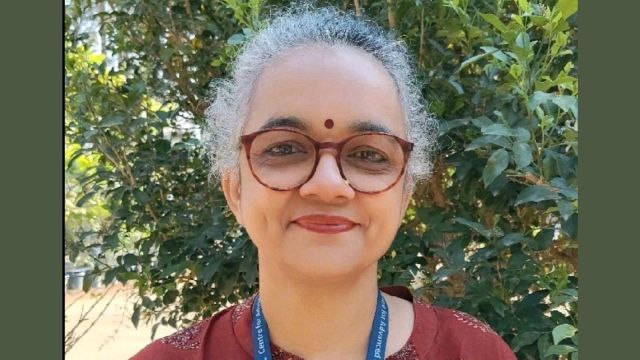Unsung Heroes: How this plant scientist from coastal Karnataka is sowing seeds of environment awareness in young minds
Dr Smitha Hegde, a professor and deputy director at Nitte University Centre for Science Education and Research, Mangaluru, is known for her Tree Count Report that turned the heads of policy makers, environmentalists.
 Dr Smitha Hegde is a distinguished professor and deputy director at Nitte University Centre for Science Education and Research (NUCSER), Mangaluru. (LinkedIn)
Dr Smitha Hegde is a distinguished professor and deputy director at Nitte University Centre for Science Education and Research (NUCSER), Mangaluru. (LinkedIn)From washing test tubes in the 1990s to pioneering phytoremediation solutions for heavy metal pollution, plant scientist Dr Smitha Hegde has carved a significant path in the fields of plant molecular biology, environmental conservation, and education.
A distinguished professor and deputy director at Nitte University Centre for Science Education and Research (NUCSER), Mangaluru, Dr Hegde is known for her Tree Count Report-2023, that turned the heads of policy makers, and environmentalists among others. A year-long study revealed an alarming 6.24 per cent depletion of green cover in urban spaces of Mangaluru, and a five-degree Celsius rise in surface temperature over a decade.
Dr Hegde’s story begins in Mumbai, where she earned an MSc in Zoology in 1991. A twist of fate brought her to Mangaluru, where she answered a newspaper advertisement for a lab assistant at St Aloysius College.
“My first job was to wash test tubes,” she recalls. Under the mentorship of Fr. Leo D’Souza, a pioneer in plant tissue culture, found her calling. She contributed to India’s first test-tube cashew plant and, by 1998, earned a PhD in Biosciences from Mangalore University, focusing on propagating native ornamental plants like ferns. “I shifted from zoology to plants and I’ve never looked back,” she says.
Her fascination with ferns—or pteridophytes—defines her career. These ancient plants, the first to transition from water to land, gripped her attention with their toughness and vast genomes. “They survived hostile conditions—volcanoes, high CO2, low oxygen,” she explains. “Their genes hold secrets we’re only beginning to understand.”
At NUCSER, where she joined in 2017, Dr Hegde has published over 67 journal papers and 32 book chapters, exploring ferns’ potential in phytoremediation—using plants to strip heavy metals like lead and cadmium from soil and water. Her two pending patents aim to harness biomaterials for cleaner drinking water, addressing a pressing modern crisis: heavy metal contamination in vegetables.
Her lab is filled with tissue-cultured ferns, grown on minimal media to test their metal tolerance. This work isn’t just academic—it’s personal. She avoids plants in the food chain for remediation, ensuring toxins don’t cycle back to humans. “Doctors always say eat vegetables, right? But now we are shocked to see the amount of heavy metals that are there in the vegetables—arsenic, chromium, lead. When we consume these plants, it gets into us, and we also do not have a proper mechanism to throw it out of the body. It plays a lot of havoc,” she says.
Further, her 2015 study in Kudremukh National Park, where she and her student DNA-barcoded ferns across 600 km, revealed their diversity and fire-fuelling potential, aiding forest management. Her publications, ranging over 77 with more than 745 citations, include groundbreaking studies like the use of LEDs to boost lipid production in microalgae for biofuels and the development of DNA barcodes for edible medicinal ferns.
Dr Hegde’s ‘Tree Count Report-Mangaluru 2023’ triggered calls for urban reforestation.
Yet, her curiosity runs deeper. She ponders why ferns carry flowering genes without blooming and how they sense altitude or revive from drought.
This ambitious project saw her and 40 student volunteers manually count 19,717 trees across 50 of Mangaluru’s 60 wards in public spaces over a year.
Funded by a modest Rs.1.5 lakh grant from Nitte University, the report maps trees by species, biomass, and carbon sequestration (2.5 million kilos annually), using GPS tagging and Excel sheets. It aimed to inform policy without fault-finding. “It took me one year… every morning, every holiday morning, counting 19,717 trees across 50 wards. It’s pure data to tell Mangalore citizens, ‘Look, you can do something.’ The hidden curriculum is to familiarise Gen Next with trees —it’s been like a tapasya to complete this task,” she says.
She envisions extending it to the remaining 10 wards and integrating technology like drones and computer vision for efficiency.
Her report reveals Mangaluru’s public green cover at 6.24%, with only 0.01 trees per person in some wards (one of the wards had 125 trees for 11,069 people). “Mangalore is green… because of private people,” she observes, cautioning that private land sales threaten this buffer.
She notes, “India is going through a crisis of desertification where 30% of its land is becoming unproductive… just because of the lack of moisture and heat.”
In Mangaluru, she reports a 2024 surface temperature peak of 47°C and a 1.5°C average rise over 10 years, linking it to concretization and tree loss. “You would think it happens only in the deserts,” she says.
he laments Mangaluru’s transformation into a “Concrete Jungle,” warning it could mirror Bangalore’s ecological decline: “Bangalore is an ecological disaster… it’s not sustainable anymore.” She cites local examples of Mangaluru where “almost all the trees on the roadside have gone” due to Smart City projects.
“Next time you see a plant, look around with the eyes of respect and curiosity and humility to know that we don’t know everything about the plant system.We don’t need to save the environment—it can save itself. We need not interfere with them, that’s it.” says Dr Hegde.
Must Read
Buzzing Now
Apr 12: Latest News
- 01
- 02
- 03
- 04
- 05


























